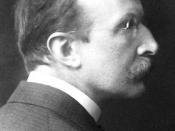The problem of continuum versus discreteness seems to be related to the issue of infinity and finiteness. The number of points in a line served as the logical floodgate which led to the development of Set Theory by Cantor at the end of the 19th century. It took almost another century to demonstrate the problematic nature of some of Cantor's thinking (Cohen completed Godel's work in 1963). But continuity can be finite and the connection is, most times, misleading rather than illuminating.
Intuition tells us that the world is continuous and contiguous. This seems to be a state of things which is devoid of characteristics other than its very existence. And yet, whenever we direct the microscope of scientific discipline at the world, we encounter quantized, segregated, distinct and discrete pictures. This atomization seems to be the natural state of things - why did evolution resort to the false perception of continuum? And how can a machine which is bound to be discrete by virtue of its "naturalness" - the brain - perceive a continuum?
The continuum is an external, mental category which is imposed by us on our observations and on the resulting data.
It serves as an idealized approximation of reality, a model which is asymptotic to the Universe "as it is". It gives rise to the concepts of quality, emergence, function, derivation, influence (force), interaction, fields, (quantum) measurement, processes and a host of other holistic ways of relating to our environment. The other pole, the quantized model of the world conveniently gives rise to the complementary set of concepts : quantity, causality, observation, (classic) measurement, language, events, quants, units and so on.
The private, macroscopic, low velocity instances of our physical descriptions of the universe (theories) tend to be continuous. Newtonian time is equated to a river.


